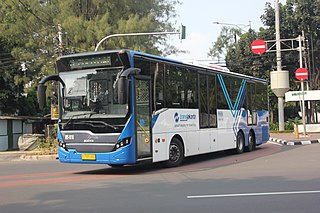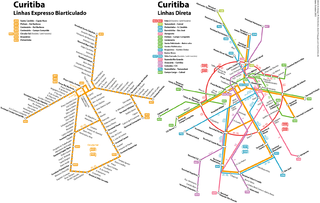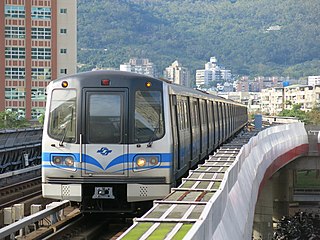
Bus rapid transit (BRT), also referred to as a busway or transitway, is a bus-based public transport system designed to have much more capacity, reliability and other quality features than a conventional bus system. Typically, a BRT system includes roadways that are dedicated to buses, and gives priority to buses at intersections where buses may interact with other traffic; alongside design features to reduce delays caused by passengers boarding or leaving buses, or paying fares. BRT aims to combine the capacity and speed of a light rail transit (LRT) or mass rapid transit (MRT) system with the flexibility, lower cost and simplicity of a bus system.

TransMilenio is a bus rapid transit (BRT) system that serves Bogotá, the capital of Colombia, and Soacha. The system opened to the public in December 2000. As of 2022, 12 lines totalling 114.4 km (71 mi) run throughout the city. It is part of the city's Integrated Public Transport System, along with the urban, complementary and special bus services operating on neighbourhoods and main streets.

Rede Integrada de Transporte is a bus rapid transit (BRT) system in Curitiba, Brazil, implemented in 1974. It was one of the first BRT systems in the world and a component of one of the first and most successful examples of transit-oriented development.

Janmarg, also known as Ahmedabad BRTS, is a bus rapid transit system in Ahmedabad, Gujarat, India. It is operated by Ahmedabad Janmarg Limited, a subsidiary of Ahmedabad Municipal Corporation and others. It is designed by CEPT University. It was inaugurated in October 2009. The network expanded to 89 kilometres (55 mi) by December 2017 and 160 km by March 2023; with daily ridership of 3,49,000 passengers. BRTS won several nation and international awards for design, implementation and operation. It was rated Silver on BRT Standard in 2013.

The Institute for Transportation and Development Policy (ITDP) is a non-governmental non-profit organization that focuses on developing bus rapid transit (BRT) systems, promoting biking, walking, and non-motorized transport, and improving private bus operators margins. Other programs include parking reform, traffic demand management, and global climate and transport policy. According to its mission statement, ITDP is committed to "promoting sustainable and equitable transportation worldwide."

Public transport is a system of transport for passengers by group travel systems available for use by the general public unlike private transport, typically managed on a schedule, operated on established routes, and that charge a posted fee for each trip. There is no rigid definition of which kinds of transport are included, and air travel is often not thought of when discussing public transport—dictionaries use wording like "buses, trains, etc." Examples of public transport include city buses, trolleybuses, trams and passenger trains, rapid transit and ferries. Public transport between cities is dominated by airlines, coaches, and intercity rail. High-speed rail networks are being developed in many parts of the world.
The Urban Partnership Agreement (UPA) is an effort of the United States Department of Transportation and agencies in four metropolitan areas across the country which are testing out several technologies as an effort to reduce congestion in urban areas. The metro areas of Miami, Florida, Minneapolis, Minnesota, San Francisco, California, and Seattle, Washington are participants. The technologies being used include bus rapid transit (BRT), high-occupancy toll lane (HOT) lanes and other congestion pricing, dynamic message signs, and other lane management signage.
Michael Replogle is an internationally recognized expert and advisor in the field of sustainable transport. He co-founded the Institute for Transportation and Development Policy (ITDP) in 1985, a nonprofit organization that promotes environmentally sustainable and equitable transportation projects and policies worldwide, as well as Bikes Not Bombs in 1984. He was the president of ITDP from 1985–1992 and 1998-2009, and managing director of ITDP from 2009-2015. His seminal 1987 paper on sustainable transport was the first to define the term.

The Cebu Bus Rapid Transit System is a mass transit system under construction in Cebu City, Philippines. It is expected to become the first operational bus rapid transit project in the Philippines. Only one line has been planned in detail so far, but scheme developers note the potential to develop a larger network comprising the adjacent cities of Lapu-Lapu, Mandaue, and Talisay, all of which, together with Cebu City, form part of the Cebu metropolitan area.

Bus rapid transit in New Jersey comprises limited-stop bus service, exclusive bus lanes (XBL) and bus bypass shoulders (BBS). Under the banner Next Generation Bus New Jersey Transit (NJT), the New Jersey Department of Transportation (NJDOT), and the metropolitan planning organizations of New Jersey (MPO) which recommend and authorize transportation projects are undertaking the creation of several additional bus rapid transit systems (BRT) in the state.

Bus rapid transit creep is a phenomenon commonly defined as a bus rapid transit (BRT) system that fails to meet the requirements to be considered "true BRT". These systems are often marketed as a fully realized bus rapid transit system, but end up being described as more of an improvement to regular bus service by proponents of the "BRT creep" term. The Institute for Transportation and Development Policy published several guidelines in an attempt to define what constitutes the term of "true BRT", known as the BRT Standard, in an attempt to avert this phenomenon.

The BRT Sunway Line is a bus rapid transit (BRT) line that is part of the Klang Valley Integrated Transit System servicing the southeastern suburbs of Petaling Jaya, Malaysia. It is world's first all-electric Bus Rapid Transit system.

The Sustainable Transport Award (STA), is presented annually to a city that has shown leadership and vision in the field of sustainable transportation and urban livability in the preceding year. Nominations are accepted from anyone, and winners and honorable mentions are chosen by the Sustainable Transport Award Steering Committee.

The BRT Standard is an evaluation tool for bus rapid transit (BRT) corridors around the world, based on international best practices. The Standard establishes a common definition for BRT and identifies BRT best practices, as well as functioning as a scoring system to allow BRT corridors to be evaluated and recognized for their superior design and management aspects.

sbX is a bus rapid transit (BRT) service in San Bernardino and Loma Linda, California, United States. It is operated by Omnitrans, a public transportation agency in southwestern San Bernardino County. The route is internally named by Omnitrans as the Green Line.
Tiruchirappalli BRTS is a proposed bus rapid transit system for the city of Tiruchirappalli.
Tiruchirappalli Bicycle Share is a new proposed bicycle sharing system for the city of Tiruchirappalli.

Rainbow BRTS is a bus rapid transit system in the city of Pune. The system is operated by the Pune Mahanagar Parivahan Mahamandal Limited (PMPML). The infrastructure has been developed by the Pune Municipal Corporation & Pimpri Chinchwad Municipal Corporation, Pune. The project currently envisages 113 km of dedicated bus corridors along with buses, bus stations, terminals and intelligent transit management system.

CMAX is a bus rapid transit (BRT) service in Central Ohio, operated by the Central Ohio Transit Authority (COTA). The line begins in Downtown Columbus, traveling northeast to Westerville. CMAX is Central Ohio's first bus rapid transit line; it began operation in 2018.
















